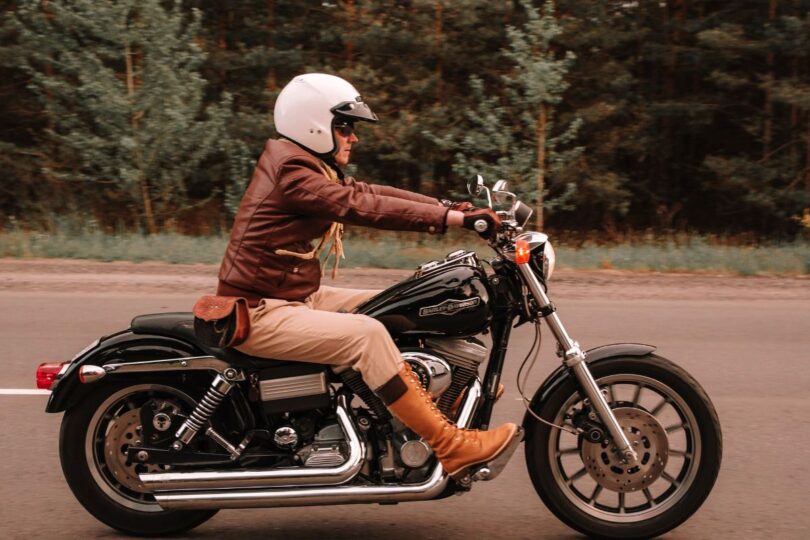Discussions about the right choices of protective motorcycle clothing are as old as the means of transportation itself. While they typically cover whether it is necessary to wear specific types of gear at all, some deal with the right material choices.
Whether it is because of the price, personal taste, or ethics; some riders decide to buy protective motorcycle clothing made from leather, while others prefer other textiles like synthetic fabrics. Is there a clear winner among the two options when it comes to cost, efficiency, and comfort?
Important Characteristics of Protective Motorcycle Clothing
To determine whether leather or textiles are good choices for motorcycle clothing, we should look at the essential characteristics the motorcycle gear is supposed to have.
Motorcycle gear, as a whole:
- Protects From Injuries & Outside Influences
- Helps Control the Bike
- Keeps the Rider Comfortable, Concentrated & Nimble
The material choices should thus be robust enough, to be abrasion-resistant, and offer effective protection against weather influences, like rain, wind, snow, and UV-rays.
They cover us to protect us from sunburn, are airtight, and usually water-resistant or even waterproof. At the same time, the material can warm our body or help us cool down.
Additional elements, next to the fabric itself, like padding and armor plating, protect our bones from breaking in impacts.
Lastly, by using the right materials, we can control the motorcycle more efficiently. For example, when increasing the grip we have on the bike, and lower the effects of the bike’s vibration that would numb our fingers over time, when wearing motorcycle gloves.
Leather vs. Fabrics – Differences, Pros & Cons
When we look at the different options for motorcycle clothing on a professional vendor’s website, like ChromeBurner.com, we can tell that these helpful features of motorcycle clothing are typically achieved by several layers of different materials.
Even traditional motorcycle clothing, like the standard leather motorcycle jacket, often combine layers of leather with linings made from other fabrics, like insulating wool or breathable synthetic fibers, to get the best of both worlds.
When it comes to the discussion of leather vs fabrics, we typically talk about the outer shell of the motorcycle clothing. Here, we find top layers made from leather or synthetic textiles with similar abrasion-resistance.
Leather Motorcycle Clothing
Leather is the most commonly used material for the outer layer of motorcycle clothing.
Leather is:
- robust – it can withstand high combustion temperatures and thus high friction as well as cuts from sharp objects
- a natural product – while animal lovers might be against leather products, overall, the material is much more sustainable and eco-friendly than any synthetic fiber
- flexible – leather can adapt itself to the wearers body and movements over time, while it starts out stiff, it becomes a second skin after a bit of breaking in
- tight-fitting – thanks to leather fitting like a second skin, it stays in place, and protective elements, like armor plates, do not shift from the most vulnerable spots they are supposed to protect
However, some of these advantages also turn into downsides. A full set of leather motorcycle clothing is heavy, stiff, and less comfortable than fabric clothing. When you are motorcycle touring in the L.A. sun, you might not want to clad yourself in thick, dark, heavy leather.
Downsides to leather are:
- cumbersome
- absorbs water
- can dry out
- is bad at temperature regulation
- is more expensive
- needs more care
Textile Motorcycle Clothing
Thanks to scientific breakthroughs in textile research, the industry has developed light and flexible textiles that have the same or even a higher abrasion-resistance than leather. Typically, these robust fabrics are a mixture of a regular fiber, like denim, and a synthetic material. A popular example in motorcycle racing gear is Kevlar.
The synthetic textile
- has ballistic grade protection levels, but
- remains light as street clothing.
It is more practical in many ways, including the process of putting it on, storing it, and combining it with helpful elements like ventilation zippers.
- Overall, textile motorcycle clothing is easier to carry and put on.
- Wearing textile motorcycle clothing, the rider has more freedom of movement and comfort.
However, these jackets do not adjust themselves to the wearers body, since they are non-flexible.
Additionally, the synthetic character can be seen as non-eco-friendly.
Conclusion
Both textile and leather motorcycle jackets and clothing are durable and protective. Overall, the textile clothing wins the comparison. It is cheaper, lives longer, and is more practical in the day to day.
The main difference between leather and the synthetic fabric jackets is that leather is a natural material and has a specific feel and vibe to it. There is a reason that leather jackets inspired by the first motorcycle protective clothing have entered regular fashion and mainstream media as a sort of cult item. With the right care, a leather jacket can last a long time and turn into a comfortable second skin that is worth the higher price.
Many motorcycle riders invest into motorcycle clothing of both varieties and use the one that is more suitable to individual rides.
Photo by Marina Raspopovara








